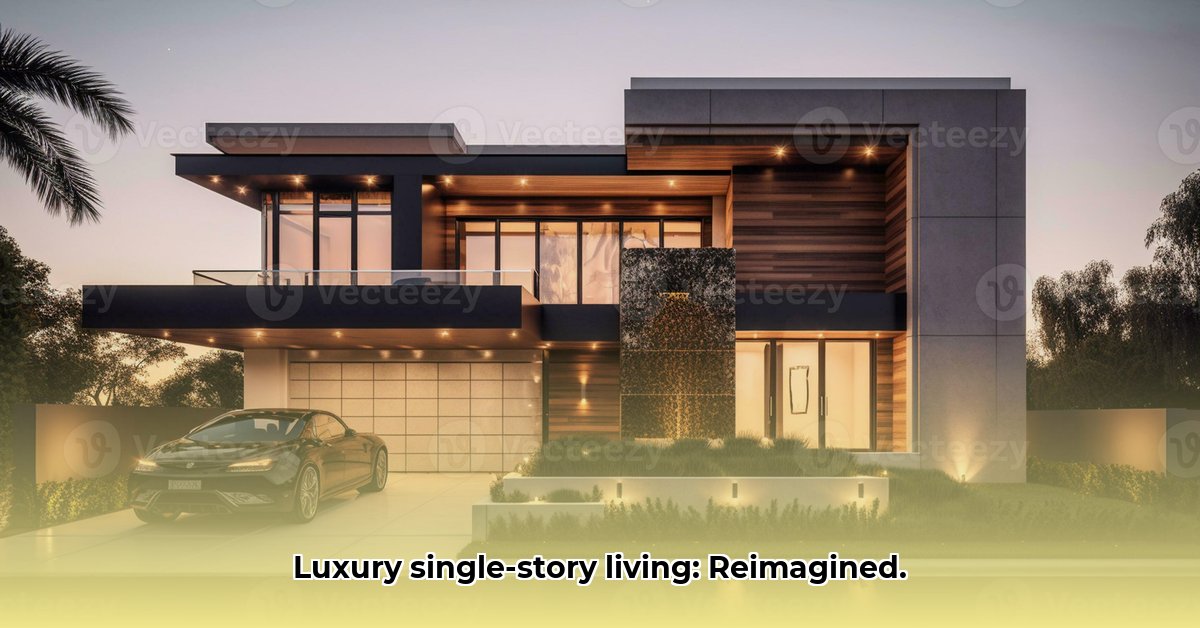Forget climbing stairs! Single-story homes are making a stylish comeback, offering both practicality and a touch of luxury. Discover why modern one-level living is trending, from smart designs to accommodating diverse lifestyles. This isn’t just about aesthetics; it’s about building a future on solid ground. For more modern single-story designs, check out these modern house plans.
The Resurgence of Single-Story Living: Design Trends
Single-story living isn’t just a trend; it’s a lifestyle shift. Forget the old image of cramped ranch houses. Today’s modern one-floor homes boast sleek designs, spacious layouts, and a focus on accessibility. This resurgence caters to everyone, from young families seeking convenience to those planning for comfortable aging. What design elements are driving this shift?
The popularity of single-story homes is largely due to:
- Accessibility: Eliminating stairs makes homes safer and more convenient for residents of all ages and mobility levels.
- Open Floor Plans: Seamless transitions between living spaces create a spacious, airy feel, perfect for modern lifestyles.
- Design Versatility: Today’s single-story homes come in a wide range of architectural styles, from modern farmhouse to contemporary, catering to diverse tastes.
Modern Meets Cozy: Key Design Elements and Home Efficiency
The best modern single-story homes seamlessly blend function and beauty. Think expansive windows, clean lines, and an emphasis on integrating the outdoors. Open floor plans create a natural flow between the kitchen, living room, and dining areas, fostering connection and convenience. How do these design choices impact the overall living experience?
Architectural styles like modern farmhouse, contemporary, and updated French country seamlessly blend to create warm, inviting homes. Smart home technology is also playing a crucial role, with automated lighting, climate control, and security systems enhancing both convenience and energy efficiency. Sustainable materials and features contribute significantly to eco-friendly living by reducing environmental impact and promoting resource conservation.
Cost Considerations, Zoning Regulations, and Sustainability Factors
Building a single-story home can sometimes be more expensive than a two-story home due to the need for a larger lot and more extensive foundation. However, careful planning, smart material choices, and energy-efficient features can help manage costs. Potential homeowners can navigate these challenges by conducting thorough site assessments, comparing bids from multiple contractors, and exploring cost-saving design options, such as smaller footprints and efficient layouts.
Actionable Intelligence for Stakeholders, from Buyers to Builders
The growing demand for modern single-story homes presents opportunities for key players in the construction and real estate industries. Each group can take specific actions to capitalize on this trend:
- Home Builders: Streamline construction processes and focus on efficient designs to reduce costs and improve project timelines.
- Architects & Designers: Prioritize universal design principles and maximize outdoor living spaces to cater to a broad range of homeowner needs.
- Real Estate Agents: Highlight the lifestyle benefits of single-story homes to target specific demographics, such as aging adults and young families.
The advantages of a well-designed modern single-story home are clear: luxury, accessibility, and practicality rolled into one. By understanding market trends and addressing potential challenges, you can create your perfect single-story haven. Is single-story living right for you? Consider your individual needs, lifestyle preferences, and budget to make the best decision for your future.
Zoning Regulations for Single-Story Modern Home Construction: Smart Home Integration
Navigating local zoning ordinances can be complex, but it’s a critical step in building your dream single-story home. Zoning regulations dictate permitted building heights, setbacks, and lot coverage, significantly impacting your project. Securing necessary permits early can prevent costly delays and design revisions. What are the key steps to navigate this process successfully?
Here’s a straightforward guide to navigate zoning regulations:
- Thorough Research: Contact your local planning department to access current zoning regulations.
- Consult Professionals: Engage a qualified architect and builder familiar with local codes.
- Design and Planning: Create a design that complies with all applicable regulations.
- Permit Application: Submit a complete application with all necessary drawings and documentation.
- Compliance Monitoring: Regularly consult with professionals to ensure continued compliance throughout the project.
Leveraging Technology and Proactive Planning for Streamlined Compliance
Building Information Modeling (BIM) software allows you to virtually model your home, ensuring code compliance before construction begins. This proactive approach can save time and money by identifying and addressing potential issues early on. There can be potential cons to navigating complex restrictions, including increased upfront costs for professional services and potential design compromises to meet regulatory requirements.
While DIY enthusiasm is admirable, seeking professional help from architects, experienced builders, and permit expediters can significantly simplify the process. They can anticipate potential roadblocks and guide you through the intricate pathways of building codes. By embracing technology and planning ahead, you can navigate zoning regulations effectively and bring your single-story home vision to life. Is the cost worth it? Consider the potential savings in time, stress, and costly errors when deciding whether to invest in professional guidance.
Modern Single-Story House Plans for Small Lots: Compact Design
The demand for Modern Single-Story House Plans for Small Lots is surging, driven by a desire for accessible, streamlined living and demographic shifts. Small-lot living offers many advantages; however, higher land and foundation costs present challenges. Innovative design solutions are crucial to mitigating the cons. What makes these designs so appealing?
Efficiency and Elegance: Balancing Aesthetics With Practicality
Several key design elements contribute to the success of single-story small lot homes. Open floor plans create a sense of spaciousness, while large windows maximize natural light. Built-in storage solutions minimize clutter. This is functional design, not merely aesthetic choices, that enhances the living experience. How can homeowners balance modern aesthetics with the practical needs of everyday living? By prioritizing multi-functional spaces, minimalist design principles, and carefully selecting furniture and décor that maximize both style and utility.
Speaking on balancing modern aesthetics with practicality, [Sarah Johnson, Lead Architect], [Principal Architect] at [Johnson Architects], emphasized, “The challenge lies in seamlessly blending modern aesthetics with practicality, offering comfortable living through thoughtful space planning and innovative storage solutions.”
The Future of Space Optimization via Small Lot Living
The demand for Modern Single-Story House Plans for Small Lots will continue to rise as land becomes more scarce and costly. The appeal of a low-maintenance, accessible, and stylish home is undeniable. Smart design is not merely a trend; it’s a response to evolving lifestyle needs.
Key Considerations:
- The upfront costs related to land prices.
- Foundation challenges, particularly in areas with poor soil conditions.
- Construction material costs, which can fluctuate significantly.
Long-Term Considerations: Aging and Enhanced Sustainability
Single-story designs are inherently well suited for aging in place. Eliminating stairs promotes safety and accessibility. Furthermore, sustainable design practices contribute to both cost savings and environmental responsibility. Building for a better future is a smart choice. What long-term factors should homeowners prioritize? Energy efficiency, water conservation, and the use of durable, low-maintenance materials.
Luxury Single-Story Modern Home Designs with Accessibility Features: Future Proofing Designs
The demand for Luxury Single-Story Modern Home Designs with Accessibility Features is soaring. Convenience and accessibility are key drivers. These homes offer the ultimate comfort and convenience from expansive open-plan living areas to gourmet kitchens seamlessly flowing into family rooms. What design choices optimize luxury and accessibility?
Luxury Single-Story Modern Home Designs trends:
- Open floor plans, promoting seamless flow and social interaction.
- Seamless indoor-outdoor living spaces, blurring the lines between the interior and exterior.
- Varied architectural styles – Ranch, Farmhouse, Craftsman, Contemporary, Mediterranean, and Southwestern, catering to diverse aesthetic preferences.
Accessibility: A Cornerstone that Enhances Modern Luxury Home Designs
Accessibility is not an afterthought; it’s a fundamental element. Wider doorways, zero-step entries, and thoughtfully placed fixtures are often incorporated. These details create a home effortlessly navigable for people of all ages and abilities. These homes are designed to age gracefully with their owners.
Local building codes, zoning regulations, plus smart home integration enhance both energy management and accessibility. Smart home technology can automate lighting, temperature, and security systems, providing greater control and convenience for residents.
Navigating the Market: Challenges and Actionable Solutions
While the demand is high, there are challenges. Addressing them will be vital for builders and buyers alike.
| Stakeholder | Short-Term Actions | Long-Term Actions |
|---|---|---|
| Home Builders | Offer customizable single-story plans, incorporating accessibility features. | Develop standardized energy efficiency metrics for single-story homes, promoting sustainability. |
| Architects | Prioritize designs maximizing indoor-outdoor flow and natural light. | Integrate smart home technology for energy management and accessibility, enhancing user experience. |
| Real Estate Developers | Target buyers seeking accessibility and convenience, emphasizing the lifestyle benefits. | Explore innovative financing options, addressing diverse buyer needs and promoting affordability. |
| Homeowners/Buyers | Research local building codes and energy-efficiency options. | Consider long-term maintenance costs and accessibility needs in your final choices. |
Actionable Steps and Future Considerations
Speaking on challenges in the market, [Mark Thompson, Real Estate Analyst], [Senior Analyst] at [Thompson Realty Group], stated, “While the demand is high, more data is needed to analyze energy efficiency and cost variance. Understanding regional building codes
- Glass Tile Shower Ideas to Create a Stunning Bathroom Space - December 7, 2025
- Glass Wall Tile Ideas for Kitchens and Bathrooms - December 6, 2025
- Glass Tile Bathroom: Create a Beautiful, Easy-Clean Space - December 5, 2025










